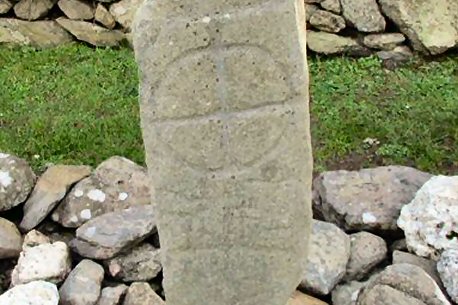Type: Cross Inscribed
Townland: GallrosShelter for foreigner(s)

The stone was examined and drawn by Chatterton in 1838.
She described it as outside the oratory and 'Near the east end', adding that it was not upright but 'in a slanting position' ...
Windele saw it in June of the same year and described its location as 'at the NE angle of the Cell in the little burying ground attached ...'
In 1878 Petrie said the stone was 'at the east end of the oratory' and his illustration suggests that the stone was still in the position described by Chatterton and Windele ... in 1898 the stone as still `close to the Oratory ... on the north-east side' ...
In 1949 Macalister described the stone as 'Formerly prostrate, but now standing in the graveyard surrounding the ancient oratory. Photographs published by Barrington (1979) and by Weir (1980) show the stone surrounded by grass but by 1986 it had been placed in its present position, set in a bed of stones'.
'The AC of MAC is very faint, the following D barely traceable: it might be C or A. The D is followed by IN, not by M. The last letter is most likely T, though it might also be C; certainly not L. The old reading MAC MEL is wrong'.
CommentaryMacalister/1949, 96: 'The inscription on the lower part of the stone has been variously interpreted in the past and is now extremely faint. Macalister... gave the reading: COLUM MAC DINET The 1st word can still be read but the other two are not clear. MAC is possible but not certain. Dinet is also possible but the 1st letter is barely traceable, the next could be M or IN, the E is clear and the final letter appears to be a C but could possibly be T'. Cuppage et al/1986, 289: 'The text is in insular script, possibly minuscule ... The second line remains uncertain. Macalister read it as mac dinet. Although he admitted that the letters A and C were `very faint', the D `barely traceable' and the T might have been C ... Macalister's IN is more plausibly interpreted as M and, although the E is clear, the final letter appears to be a C not T'. Okasha/Forsyth/2001, 148--149: Okasha/Forsyth/2001, 148: 'Formerly prostrate, but now standing in the graveyard surrounding the ancient oratory'. Macalister/1949, 96: 'The cross-slab stands at the E end of a low rectangular mound or bed of stones, including much quartz, which measures 9m E--W x 5m N--S'. Cuppage et al/1986, 289:.
Site recorded by:Helene Brennan